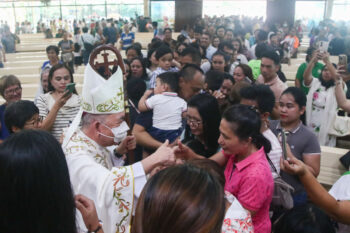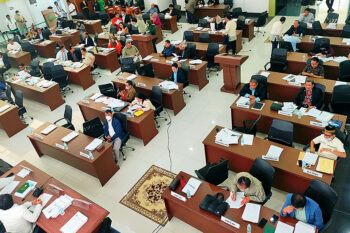
DAVAO CITY (MindaNews / 9 Nov) – Long before there was Synodality, there was the Mindanao-Sulu Pastoral Conference Secretariat (MSPC). The word Synodality has become a popular term for Catholics not just in the Philippines but throughout parts of the world with heavy Catholic population since Pope Francis convened a Synod on Synodality in October 2021.
First, we need to explain what Synodality and MSPC are for the benefit of readers who are not familiar with the vocabulary involving Roman Catholics as well as for baptized KBL Catholics – namely, those who only enter the church to attend sacramental ceremonies as Kasal (Wedding)-Bunyag (Baptism)-Lubong (Funerals).
A “synod” (from the Greek term meaning a journey together; in Pilipino – kasama-sa-lakbay, and in Cebuano-Bisaya – dungan-panaw) is a journey of discernment rooted in the Holy Spirit. In the Synod on Synodality, (this is the 16th convened so far by the Popes) the entire Church has been called to discern how the Spirit is moving through and with the Body of Christ – inside and outside the Church – so that we may continue to fulfill our mission to evangelize in the world. This Synod’s theme is: For a Church Journeying Together: Communion, Participation and Mission.
Synodality indicates walking together and listening to one another but above all to the Holy Spirit. To deepen this essential characteristic of the Church, the upcoming synod is unlike any previous one. It starts with, and involves all, the faithful at local Churches across the world, promising to listen to all, especially to laypeople. That is why this Synod is a three-year process, starting from October 10, 2021 to October 2024. From the parishes to dioceses to Local Churches, discussions were to be held, out of which reports will then be submitted to the Vatican.
The Mindanao-Sulu Pastoral Conference is the coming together of bishops, priests, religious and lay people from the various Archdioceses/Dioceses/Prelatures across Mindanao and Sulu. It usually lasts for three days and is held every three years. The first conference was held in Davao City in 1972 just before Marcos declared martial law. There have been 16 MSPCs conducted since the first one.
During an MSPC, where the participants are dominated by the laity, everyone is considered equal on the basis of their baptism. In theory everyone can speak and take part in deciding what would then be the pastoral priorities of the Local Church. MSPC is credited for having led to the organizing of Base Ecclesial Communities (Gagmayng Kristohanong Katilingban) across Mindanao and which has spread across the country
Now comes the 17th MSPC with the theme THE GIFT OF FAITH AND NEW EVANGELIZATION AS A SYNODAL CHURCH, which is currently ongoing at the Chali Beach Resort & Conference Center, Cugman, Cagayan de Oro City, which started last Monday (November 7) and will end on Friday (November 11).
Between 1972 (the first MSPC) and 2021 (when Pope Francis announced the Synod on Synodality) is a period of 47 years, nearly half a century. In other words long before the Head of the Roman Catholic Church thought of emphasizing the need of a Church journeying together (meaning a Church not just dominated by the clergy – bishops and priests – in terms of decision-making processes), this was supposedly done in practice already across the Mindanao-Sulu Church, thanks to the vision of MSPC.
However, Pope Francis’ push for journeying together was already articulated in the Second Vatican Council (1962-65) by the ecclesiological discourse of Church as People of God, that is, all baptized Catholics constitute the Church. But like many traditional institutions, it takes years before changes and reforms can be implemented since until today the Church remains one characterized by clericalism. The Mindanao-Sulu church, however – thanks to the leadership of the Mindanao bishops active in the ’60s to ’80s, especially the late Bishops Bienvenido Tudtud (Marawi), Carmelo Morelos (Butuan), Antonio Nepomuceno OMI (Cotabato), Jesus Varela (Ozamiz), Federico Escaler (Kidapawan), Francisco Claver SJ (Malaybalay) – made concrete steps towards what would now be called a Synodal Church.
What made possible a praxis where a group of clergy and lay people could sit together and actually decide on what needs to be done collectively was because the MSPC had a structure that facilitated such collaborative efforts. There was a Board made up of two Bishops, a representative of the diocesan clergy, another for the religious and three (later on expanded to six) lay people from the sub-regions. To make sure that their decisions were implemented, there was a Secretariat made up of staff members (priests, religious and lay people) who were tasked the job of following up on the recommendations. This made the MSPC progressively alive from 1972 to the mid 1980s.
Then just as it had moved forward, the bishops decided to move backward. Influenced by the witch-hunting (now popularly known as red-tagging) that arose in the early 1980s when many pastoral institutions (including the MSPC Secretariat and its networks across the dioceses) were supposedly infiltrated by the NDF-CPP-NPA – resulting from a massive propaganda instituted by the Marcos regime and its intelligence networks – the bishops suspended the convening of the Conference and closed the Secretariat office. At the diocesan level, those who were in the network of the MSPCS were also disbanded. Thus ended the synodality process which has begun to grow and produced fruits.
The question now is will the 17th MSPC – now ongoing – trace back this trajectory of its contemporary history to learn the lessons that could then make possible concrete recommendations following the theme of Synodality which can synchronize with Pope Francis’ synodality project? This is the challenge facing the delegates at this conference in Cagayan de Oro right now. It means to be rid of the trauma of the witch-hunting years, to learn the lessons of the past, and possibly decide to set up again a structure that would make possible collective synodal decision-making process which can only be possible if you have the kind of Board and Secretariat of its first 14 years of existence.
But would the bishops allow this to happen? For all this talk of lay empowerment and now journeying together with the laity side-by-side with the bishops and clergy, we all know that power in the Church remains in the hierarchy. Would our bishops heed the call of Pope Francis and allow this synodal process to really move towards the rise of a People of God who can hold hands together, pray together, decide together and act together as a Church of the Poor?
We will know shortly the answer to this question and if the movement is a favorable response, then future Church historians can write – Mindanao Church history repeats itself!
[MindaViews is the opinion section of MindaNews. Redemptorist Brother Karl Gaspar is a professor at St. Alphonsus Theological and Mission Institute in Davao City and until recently, a professor of Anthropology at the Ateneo de Davao University. Gaspar is Mindanao’s most prolific book author. He writes two columns for MindaNews, one in English (A Sojourner’s Views) and the other in Binisaya (Panaw-Lantaw). He is a Datu Bago awardee, the highest honor the Davao City government bestows on its constituents.]






